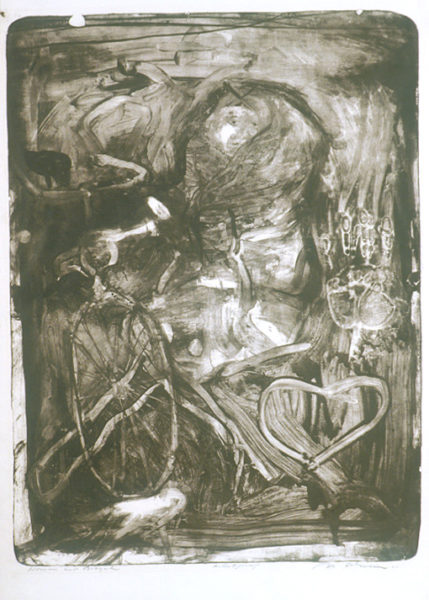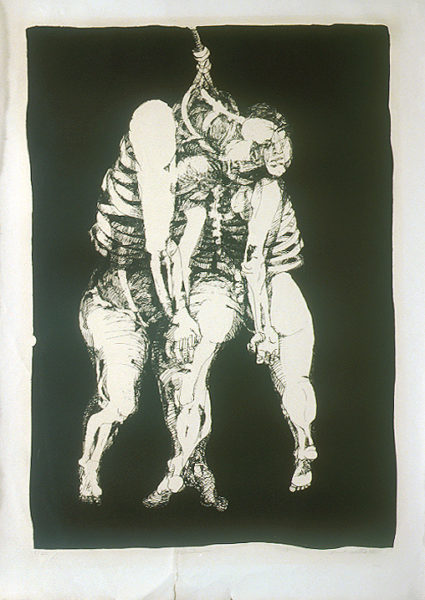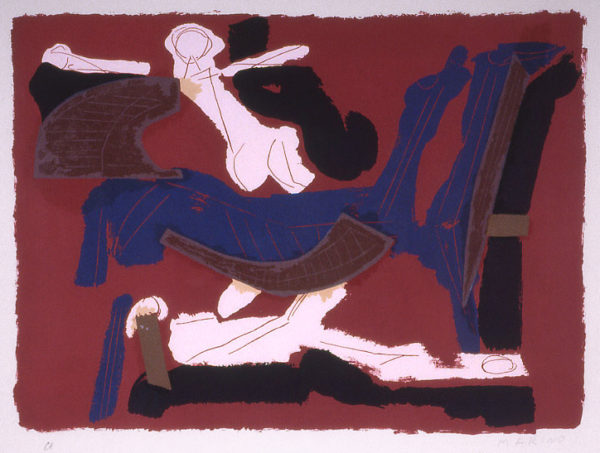
Nathan Oliveira, American, 1928–2010, Woman and Bicycle, 1961, print, 31 9/16 in. x 23 5/16 in., Gift of Mr. and Mrs. Fred Marer, Scripps College, Claremont, CA
Selected Prints (1960–1972): Woman and Bicycle, Execution, Horse and Rider
Introduction The global art scene in the post-World War II era is filled with new ideas and new forms. An influential trend is abstract expressionism developed by American painters such as Jackson Pollock and Willem de Kooning in the 1940s and 1950s. Represented by random paint strokes and splashes created by Pollock, the movement advocates an anti-figurative aesthetic and emphasizes intuitive motions involved in ways of creation. In the postwar era, the art world witnessed the merging of cultural elements and traditional art media. Some American and European artists absorbed elements of traditional and contemporary practices and created unique styles that combined representational and abstract approaches.
The three prints discussed in this essay by Nathan Oliveira, Connor Everts, and Marino Marini were created between the years of 1960 and 1972. The works show the artists’ shared interest in combining realism and abstraction. All use biomorphic forms to convey a sense of angst. This recurring motif of bodily distortion is often associated with postwar trauma.
The artists discussed here are active in multifaceted practices including painting and sculpting, yet printmaking has always been an important medium for all of them. On “The Education of the Artist and One Print’s Progress” (1979), Connor Everts said, “One of the marvelous qualities of printmaking is the persistence of memory…. Like a dream, the print keeps taking us back to the same crossroad for yet another chance…. Print is the art of opportunity” (qtd. in Ruby 5).
The following prints act as records of the artists’ thinking processes and offer indications of their stylistic transitions. By looking closely into the works, one gains valuable insights on how the artists reconciled their experiences and how, through artistic experiments, they would comment on contemporary events.
Nathan Oliveira: Woman and Bicycle
The monochromatic print Woman and Bicycle by Nathan Oliveira is set in a murky atmosphere. The most identifiable object in the scene is a tilted bicycle tire on the left. The shape of the palm of a hand—which appears disproportionally large compared to the scale of the bicycle—floats oddly on the right. The rest of the image blends into an abstract background. There is barely a hint of depth or light, and the narrative is vague. The central silhouette suggests a figure, which could be the “woman” in the title. Ink is applied thinly around the dark outline of the figure and creates a glowing effect. The brushwork on the outer edges conveys dynamic movements, while the ambiguous background suggests a sense of isolation.
Originally aspiring to become a portrait painter, Oliveira often uses the figure as a motif in abstract works. He says that the figure would appear normal but is actually “completely abnormal in its relationship to the space” (qtd. in Tooker 57). Of Portuguese descent, Oliveira grew up in the countryside. Visiting a museum for the first time as a teenager, he was struck by a Rembrandt portrait and became interested in figurative art. He was later influenced by expressionist painters such as Oskar Kokoschka, Edvard Munch, and Max Beckmann as well as European contemporaries like Francis Bacon and Frank Auerbach. The idea of “discovering the figure” in Bacon’s obscure paintings was critical to Oliveira as a young artist (Martini 62). In the early 1960s, Oliveira devoted a great deal of time to life drawing as a part of a group with Frank Lobdell and Keith Boyle.
Often synthesizing the representational and the abstract, Oliveira’s practice seems highly personal compared to many artistic trends at the time. He says, “The whole pop event was sort of fun,” but the hundreds of pop paintings became “a terrible bore” (qtd. in Tooker 57); he is also concerned by the mannerisms of the abstract expressionist painters. Woman and Bicycle came from an initial stage in Oliveira’s exploration of his unique voice. The print combines figurative drawings and abstraction while emphasizing the action. It shows influences of past masters and contemporary painters, but also indicates the artist’s nonconformity in the face of prevailing trends.
As an artist with a longstanding interest in figurative representations, Oliveira sees body form as a symbolic medium. His figurative work emphasizes spirituality rather than realism. In Woman and Bicycle, there is no separation between the foreground and background, nor is there any hint of a light source. The concept of time and space thus becomes ambiguous. The spirituality in the abstraction provides viewers with a glimpse of a metaphysical imagination: the obscure form appears to be emerging from the muddy brushstrokes and glowing from within.
Through bodily forms, Oliveira explores the nature of humanity’s position in a larger, historical context, conveying an existential solitude in the wake of WWII. Looking at the image, one may ask: what does the floating hand represent? Where is the “woman” going? The answers remain undetermined. Yet what interests Oliveira is not a specific narrative but the spiritual sensations that figures placed in uncertain spaces radiate.
Oliveira’s understanding of symbolist figures has led to his use of gestural drawing as a fundamental process. He would start painting with a monotype, applying lots of gestural paint until the abstraction suggests a figuration (Cummings 31)—the emphasis on movement was influenced by action painting. Building upon concepts of abstract expressionism, Oliveira’s work takes a slightly different direction, focusing on the spirituality in figures whose representational forms are hidden behind pure abstraction. He says, “Every time I look at something rather incredible there is a drawing underneath it. I know all the drawing that went into it” (qtd. in Cummings 34). In his calligraphic monotypes, Oliveira incorporates deep emotions into the act of drawing, evoking existential topics in the postwar consciousness.
Connor Everts: Execution

Connor Everts, American, 1926–2016, Execution, 1960, Print, 35 11/16 in. x 24 9/16 in., Scripps College, Claremont, CA
In the lithograph, Execution, the human form evokes both death and a sense of intimacy. Against a black background, two skeletal bodies hanging from a noose are entangled. The hands of the figures clutch together; the heads droop from elongated necks and rest on each other’s body. The exposed rib bones cast shadows on pale, swollen limbs. The print was made by Los Angeles artist, Connor Everts, whose figurative drawings often create an uncanny atmosphere. Born in Bellingham, Washington, Everts moved to Los Angeles with his family and served in the U.S. Coast Guard during World War II. Later, he traveled extensively throughout Europe and South America as an art student. Although Everts enjoyed early fame as an award-winning artist, he became constantly involved in controversies of the “obscenity” in his artwork, whether in terms of stylistic choices or subject matter. In 1964, the Los Angeles police shut down an exhibition of his work at the Zora Gallery and arrested him (“Conner Everts Biography”). This was one of the most notorious events that Everts was involved in. Decades later, people were able to appreciate the sophistication in the unsettling scenes Everts depicts. The fragmented bodies were reflective of the artist’s inner struggles and the turmoil of the era. The disturbing effect in Everts’ work is manifested in bodily distortion, through which he questions mechanisms of human society and concepts of life and existence. The motifs he uses are conversations with other L.A contemporaries: the ripped organic shapes evoke the work by Rico Lebrun, and the skeletons suggest Howard Warshaw’s figurative drawings about death. In postwar artistic expression, the distortion or fragmentation of human bodies is among the most commonly used of visual languages, referring to human atrocity. In Execution, the body is visually “dissected.” The bone structure of the upper torsos is clearly shown, and the positioning of the figures is indicative of a slaughterhouse. The deformed body parts, such as the elongated necks and protruding foreheads, further eliminate human characterizations and blur the boundaries between living figures and lifeless forms. Execution strangely suggests camaraderie. The noose acts as a contact point between the two figures that share both pain and intimacy. Underneath grotesque elements, work by Everts draws attention to spiritual connection and shared trauma that transcend bodily forms.
Marino Marini: Horse and Rider

Marino Marini, Italian, 1901-1980, Horse and Rider, 1972, Print,
14 3/8 in. x 19 3/4 in., Scripps College, Claremont, CA
Marino Marini is an Italian sculptor and graphic artist who achieved international success in the post-WWII era. He is famous for his work with the equestrian theme that he consistently dealt with for decades. In his print Horse and Rider (1972), abstract shapes of human and animal forms are interwoven together. The blue shape of a standing horse extends along the horizontal line and separates the rest of the forms. A white human shape on the horse’s back seems to be outstretching both arms as if wrestling with an invisible force. The abstract forms underneath the horse echo the form of the “rider” and appear to be a reflection or a shadow. Although the image is in balanced composition and colors, it nevertheless creates a sense of motion and tension with the contorted biotic shapes. Throughout Marini’s decades-long experimentation with images of the rider and horse, his use of forms underwent tremendous changes. His obsession with the subject matter dates back to 1929 when he was a young art student in Florence. There, Marini spent many hours sketching horse at a local stable (Cutler 20), which served as a basis for his later exploration of the motif. Originally, Marini was interested in depicting harmonious interactions between the horse and rider with representational forms. He shifted the direction of his practice in the 1940s by using increasingly generalized forms in expressive styles. In Horse and Rider, the abstract “horse” holds its neck straight and the head up, as if bearing some kind of pain. The human and animal bodies are fragmented, and their gestures are exaggerated. The unity that existed in his previous work is now replaced by tension and pain. As Marini says, “My equestrian figures are symbols of the anguish that I feel when I survey contemporary events. Little by little, my horses become more restless, their riders less and less able to control them” (qtd. in Cutler 24). A chronological examination of Marini’s work reveals an emotional transformation that the artist went through. Horse and Rider is an example of Marini’s later body of works, and it reflects his struggles with accepting reality and his attempt to capture the bestiality hidden inside humanity. Marini’s practice is also unique due to the use of a common, classical subject in modernist experiments. In multiple ways, Marini finds connections between contemporary issues and the equestrian theme that resonates with him. In a historical context, the connection may be found in refugees who fled Milan on horseback as allied armies invaded in tanks toward the end of the war (Hunter 16); at a more conceptual level, Marini communicates contemporary moods of anxiety and uncertainty by turning a traditional theme into expressive artwork about domination and conflict. For Marini, art is something that transcends arbitrary division of “periods.” He asks, “What is this period of ours about? Speed. This will end one day—a period is nothing when compared with eternity. Eternity, yes, there are things which belong to all periods” (qtd. in Hodin 98). Using the equestrian theme as a carrier, Marini focuses on our connection to a larger social, cultural, and historical context as well as the emotion and struggles that are fundamental to his way of perceiving humanity.
Written by Chenlu (Cindy) Zhu (SC ’19) Wilson Summer Intern 2019
Works Cited
“Connor Everts Biography: Annex Galleries Fine Prints.” The Annex Galleries, www.annexgalleries.com/artists/biography/666/Everts/Connor.
Cummings, Paul. “Interview: Nathan Oliveira Talks with Paul Cummings.” Drawing, 1988, pp. 30–34. Cutler, Ellen B. “Archetype and Allegory: Marino Marini’s Horses and Riders.” Sculpture Review, vol. 55, no. 2, June 2006, pp. 20–25.
Hodin, Joseph Paul. “Marino Marini: Man and Horse, Man and Woman; with French, Italian and German Summaries.” Studio International, vol. 167, Mar. 1964, pp. 94–99.
Hunter, Sam. Marino Marini–the Sculpture. Abrams, 1993.
Martini, Chris. “Nathan Oliveira: Cruising in the Fast Lane.” Studio International, vol. 197, no. 1007, Dec. 1984, pp. 62–63.
Ruby, Kalen. “Variations on a Theme.” Artweek, vol. 15, Dec. 1984, pp. 5–5.
Tooker, Dan. “Nathan Oliveira, Interviewed by Dan Tooker.” Art International, vol. 17, Dec. 1973, pp. 56–57.

